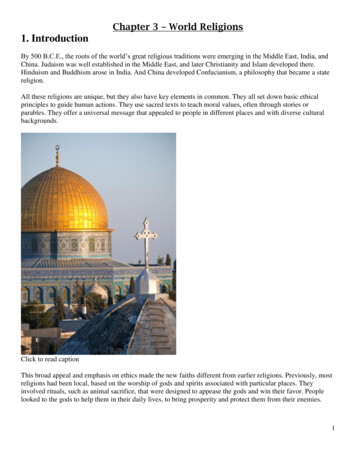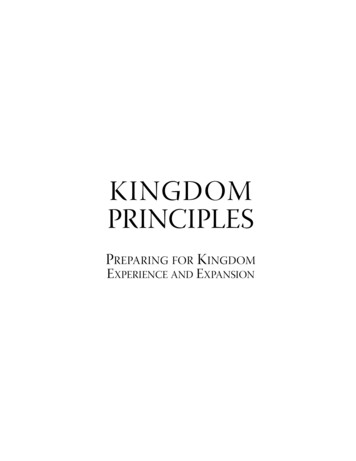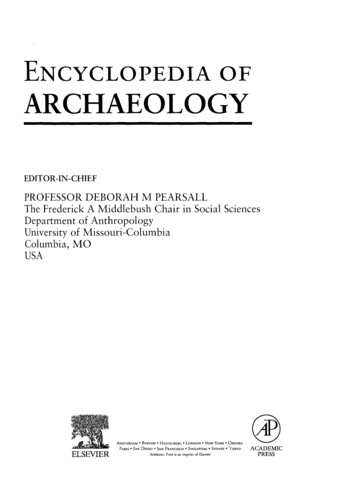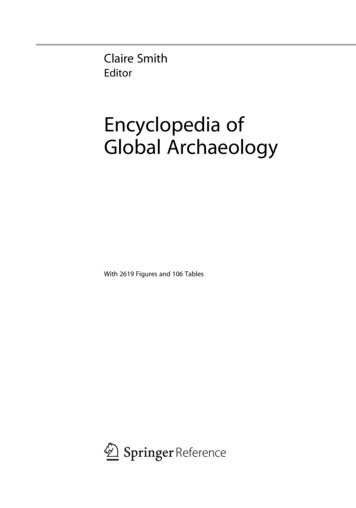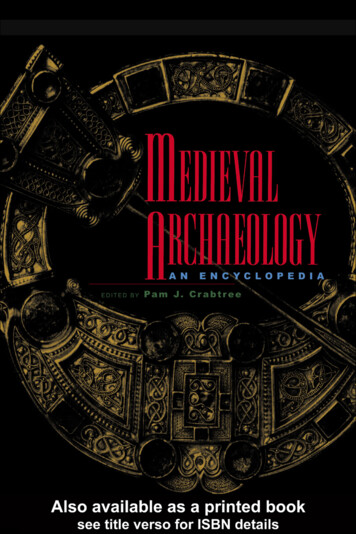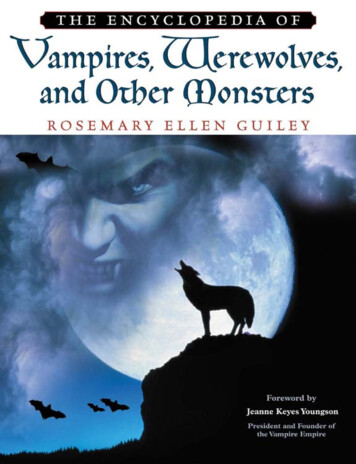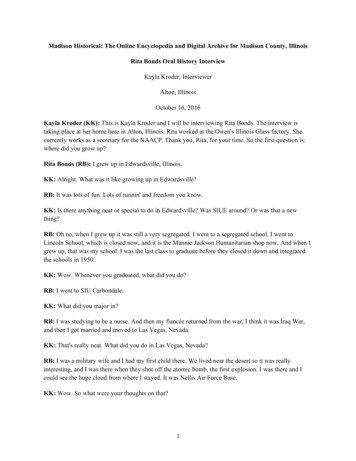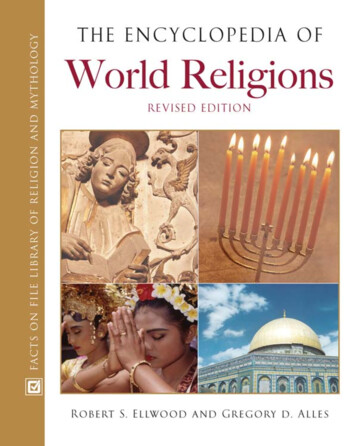
Transcription
The Encyclopedia ofWORLD RELIGIONSRevised Edition
This book was developed and written by DWJ BOOKS LLC.General Editor:Robert S. EllwoodUniversity of Southern CaliforniaAssociate Editor:Gregory D. AllesMcDaniel CollegeAdvisers and Consultants:Dr. Robert T. AndersonDepartment of Religious Studies, Michigan State UniversityDr. Frida Kerner FurmanDepartment of Religious Studies, DePaul UniversityDr. Azim A. NanjiDirector, Institutes of Ismaili Studies
The Encyclopedia ofWORLD RELIGIONSRevised EditionROBERT S. ELLWOODDistinguished Professor of Religion EmeritusUniversity of Southern CaliforniaGeneral EditorGREGORY D. ALLESProfessor and Chair, Department of Philosophy and Religious StudiesMcDaniel CollegeAssociate Editor
For my family and the future—Robert S. Ellwood, General EditorSTo my children—Gregory D. Alles, Associate EditorThe Encyclopedia of World Religions, Revised EditionCopyright 2007, 1998 by DWJ BOOKS LLCAll rights reserved. No part of this book may be reproduced or utilized in any form orby any means, electronic or mechanical, including photocopying, recording, or by anyinformation storage or retrieval systems, withoutpermission in writing from the publisher. For information contact:Facts On File, Inc.An imprint of Infobase Publishing132 West 31st StreetNew York NY 10001ISBN-10: 0-8160-6141-6ISBN-13: 978-0-8160-6141-9Library of Congress Cataloging-in-Publication DataThe encyclopedia of world religions / Robert S. Ellwood, general editor; Gregory D.Alles, associate editor. — Rev. ed.p. cm.Includes bibliographical references and index.ISBN 0-8160-6141-6 (alk. paper)1. Religions—Encyclopedias. I. Ellwood, Robert S., 1933– II. Alles, Gregory D.BL80.3.E54 2006200.3—dc222005056750Facts On File books are available at special discounts whenpurchased in bulk quantities for businesses, associations, institutions,or sales promotions. Please call our Special Sales Departmentin New York at (212) 967-8800 or (800) 322-8755.You can find Facts On File on the World Wide Web athttp://www.factsonfile.comText design by Erika K. ArroyoCover design by Ana PlePrinted in the United States of AmericaVB SG 10 9 8 7 6 5 4 3 2This book is printed on acid-free paper.
. CONTENTS ,List of IllustrationsviList of Maps and TablesviiPreface to the Revised EditionviiiPreface to the Original EditionixIntroduction: What Is This Encyclopedia About?xENTRIES A to Z1Topical Outline491Selected Bibliography496Index499
LISTOF. I LLUSTRATIONS ,John Chilembwe performing abaptism ceremony Bronze vessel used by Shang rulersto feast the ancestors Botticelli’s The Annunciation Sacred cow Zodiac Wooden bodhisattva Sitting Golden Buddha statue John Calvin, portrait Canterbury pilgrims in 15th-centurymanuscript The Cathedral of Notre-Dame Celtic goddess Epona Confucius, engraving Sphinxes lining avenue of Temple ofAmon at Karnak Charles Darwin Noah’s ark Saint Francis of Assisi Mohandas Gandhi Statue of Ganesa A procession of believers sacrificesto Demeter Menorah Indian dancers practice for Navratri Ancient Greek cup Isis nursing the child Horus Jainism symbol The execution of Joan of Arc Carl Gustav Jung portrait Martin Luther King Jr. giving speech Krishna and Radha S viSakyamuni preaching the Lotus Sutraon the Vulture Peak Portrait of Martin Luther The birth of Mahavira Prajnaparamita Engraving of Karl Marx Mayan pyramid Kaaba crowded with pilgrims Gilgamesh Hebrew tablets Dome of the Rock Shaman Passover Haggadah George Fox Page from the Qur’an Muslim women praying Altar dedicated to Jupiter Exterior of the tomb of Jalalad-Din ar-Rumi Ceremony for the full moon Guru Nanak Statue of Siva The Great Stupa Star of David Ashkenazim synagogue interior Mahakala Torah scroll Vishnu statue Voodoo scene Execution of an arsonist witchby burning at the stake Yin/Yang symbol Portrait of Bodhidharma (Daruma) 469477481486
LISTOF. MAPS AND TABLES ,The Jewish scriptures, consisting of theTorah, the Prophets and the Writings Christianity at the time of the Schism,1054 Sites of divinities worshipped by theancient Greeks Population of Jews in Europe beforeand after the Holocaust The peoples of Islam Religious sites in Japan 5186206222233186vii S
PREFACE TO THE. REVISED EDITION ,Gratified by the response to the initial publication of The Encyclopedia of World Religions,the editors have prepared a revised and muchenhanced edition of this work. The new editioncontains 100 new articles on as many fresh topics,from ACTS OF THE APOSTLES to VIETNAMESE RELIGIONS.Numerous suggestions for further reading havebeen added throughout. Many articles have alsobeen updated and expanded. The entire encyclopedia has been carefully scrutinized to ensure accuracy, to include the latest scholarship and information, and to adequately represent recent worldevents involving religion.The early years of the 21st century haveturned out to be a time in which religion is muchS viiiin the news, often in very controversial ways. Onceagain, faith has shown itself to be a major forcebehind political and international events, as wellas within the hearts of individuals. Regardless ofhow one feels about religion’s role in society, nowmore than ever, reliable and in-depth informationabout the world’s religions—an understandingof its role both today and throughout history—isessential to responsible modern citizenship. It ishoped that this encyclopedia will contribute to thatvital understanding.—Robert S. EllwoodGeneral Editor
PREFACE TO THE. ORIGINAL EDITION ,Religion is one of the most important areas ofhuman life. It has caused wars, inspired greatacts of compassion, and produced some of themost exalted literature and philosophy known tohumanity. Yet it is often difficult to get information on the world’s religious traditions, information that is not only simple and interesting to readbut also objective, not partial to the point of viewof one religious tradition or another. The purposeof The Encyclopedia of World Religions is to helpyou find this kind of information.We need always to recognize that religioncan be looked at in two ways, from outside andinside. The “outside” point of view means identifying some basic facts—for example, the history,teachings, practices, and organization of a religion,facts that can be called out during research. The“inside” point of view means taking a close look atthe people who live and worship in that tradition.To truly understand a religion as it exists for realpeople, then, you need to be able to get inside—tobegin to understand the feelings of a religion’sbelievers, their ways of looking at the world, andthe things that are most important in their religiouslives. Gaining inside understanding does not meanyou have to agree with believers or even acceptthe representations of their beliefs; it just gives youthe ability to empathize with, or have a feeling for,other peoples’ values.Although an encyclopedia like this one caneasily provide material for the outside point ofview, it is hoped it will make you interestedenough to want to also gather some inside perspectives through further reading, especially inthe sacred songs and scriptures of religions, andabove all by meeting and talking with peopleof various religious backgrounds. In the UnitedStates today, people of almost all backgroundsare accessible because temples of nearly all theworld’s religions can be found in most large cities. The religious world, in other words, not onlyis found in books but is also a living reality allaround us.As you use The Encyclopedia of World Religions, you will find that you often need to go fromone entry to another to find certain new words orideas explained. To assist you in locating information on topics related to the entry in which youbegin to read, you will notice that some wordswithin an article serve as cross-references andappear in SMALL CAPITAL LETTERS. A word in SMALLCAPITAL LETTERS indicates that there is an entrywithin the encyclopedia for that word, an entry towhich you can refer for additional information. Besure to look up any other words you do not understand in a dictionary or other reference book. Bestwishes, and welcome to the wonderful and fascinating realm of the world’s religions.—Robert S. EllwoodGeneral EditorEditor’s Note: In this encyclopedia, Japanese namesare written in the Japanese manner, with the surname first; the surname is also in small-capitalletters in cross-references. Terms derived from theChinese language are transliterated according tothe Wade-Giles system; when they appear as headwords in an entry, the Pinyin is also given.ix S
. INTRODUCTION ,What Is This Encyclopedia About ?Adolescence is a time of curiosity—about oneself, one’s friends, one’s world. The Encyclopedia of World Religions, Revised Edition, aims tohelp young people satisfy their curiosity about avery important aspect of their world: religions.Today more than ever young people in NorthAmerica encounter a variety of religions. Becauseof changes to immigration laws made in 1965, it isnow possible for people from what had previouslybeen “barred zones” to settle in the United States.This includes a large number of people from placeswhere religions such as BUDDHISM, CONFUCIANISM,HINDUISM, ISLAM, JAINISM, Parsiism, SIKHISM, SHINTO,and TAOISM are practiced. Students today are muchmore likely to have friends who practice these religions or even to practice them themselves thanAmerican students would have been in their parents’ and grandparents’ days.In addition, and significantly, after the terrorist attacks on the World Trade Center and Pentagonon September 11, 2001, the religions of the worldhave received a great deal of public attention. It iscrucial for students to learn about these religions ifthey are to become responsible citizens. For example, a couple of years ago, at a Sikh gurdwara, Imet a priest who was run off an interstate highwayafter 9/11 by a truck driver who thought he lookedlike Osama bin Laden. Ignorance about religionsand the people who practice them is somethingthat the United States can no longer afford.Unfortunately, opportunities for young peopleto learn about religions are limited. Much education in the United States does not include religiousS xstudies. (On the difference between religious studies and theology, see THEOLOGY and RELIGION, STUDYOF.) Fortunately, though, educators have begun tosee the need for such education. For example, theAmerican Academy of Religion now has a specialcommittee devoted to teaching about religionsin secondary schools, and first-rate publishershave begun to publish books in religious studiesdesigned to meet the needs of secondary schoolstudents. In this climate, it seemed only fitting toupdate this encyclopedia.The aims of The Encyclopedia of World Religions, Revised Edition, remain unchanged. It aimsto address students directly. It provides them withaccurate information about religions that they arelikely to encounter. It also provides them withinformation that they can use and understand.Generally speaking, it contains three kinds ofentries: historical entries, comparative entries, andtheoretical entries.Historical entries discuss features of specificreligions. The most basic historical entries are thoseon the major religions: BUDDHISM, Chinese religions(see CHINA, RELIGIONS OF), CHRISTIANITY, HINDUISM,ISLAM, JUDAISM. Where appropriate, the editorshave also included major entries on the personswho started or “founded” the religions: the BUDDHA, JESUS, MUHAMMAD. Many other religions havetheir own entries, too; for example, AZTEC RELIGION, CELTIC RELIGION, GREEK RELIGION, MANICHAEISM,NATIVE AMERICAN RELIGIONS, and PACIFIC OCEAN RELIGIONS. In addition, more specific entries generallysupplement the broader ones. Thus, in addition to
Introduction S xian entry on ZOROASTRIANISM, there are entries onthe PARSEES, ZARATHUSTRA, and the ZEND AVESTA.Comparative entries discuss features thatappear in several or in all religions. They introducestudents to many standard topics in the study ofreligions. Examples include entries on GOD, GODDESSES, MAGIC, MYSTICISM, RITES OF PASSAGE, SACRIFICE,and SCRIPTURE.But religions are not simply facts to berecounted and compared. They are topics aboutwhich to think. Here is where the theoreticalentries come in. The most basic theoretical entryis the one on the Study of Religions (see RELIGION,STUDY OF). Several more-specific entries discusstheories and movements in religious studies, forexample, ANIMISM, DYNAMISM, FEMINISM, FUNCTIONALISM, and TOTEMISM. Other entries discuss majorthinkers and their ideas: Émile DURKHEIM, MirceaELIADE, J. G. FRAZER, Sigmund FREUD, C. G. JUNG,Bronislaw MALINOWSKI, Karl MARX, Rudolf OTTO,and Max WEBER.In selecting entries, the editors have kept inmind that young people are especially interestedin topics that address the world in which they live.Therefore, this encyclopedia supplements the general entries on Buddhism, Christianity, Hinduism,Islam, Judaism, and PROTESTANTISM with entries onthese religions in America. It also gives preferenceto topics that young Americans are most likely toencounter, for example, the Christian theologianThomas Aquinas but not the influential Buddhistphilosopher Nagarjuna, who currently is lessoften studied in American schools, a situation thatmay change. In addition, for the revised edition,we have updated key entries to take into accountchanges in the world and its religions since thefirst edition appeared. For example, The Encyclopedia of World Religions, Revised Edition, includesentries on COMPUTERS AND RELIGION and BRAIN, MIND,AND RELIGION, among 100 others. It also devotesmore attention to Christianity in Latin America,Africa, and Asia and to the Pentecostal movementsthat have recently met with some success in theseparts of the world.The basic structure of many of the entries goesback to the ideas of Joachim Wach. These ideasare certainly not beyond criticism. For example,Wach related experience and expression in a waythat opens up all sorts of thorny philosophicalproblems. But Wach did identify three modes ofreligious expression—the theoretical, the practical,and the sociological—that are helpful in organizing material for beginning students. Although ourmajor entries use simpler words, Wach’s threebasic divisions remain. Moreover, entries generallydiscuss a religion’s history before considering itstheoretical, practical, and social aspects.Finally, a few other useful distinctions shouldbe noted. For example, throughout most of theentries, readers will find themselves directed bycross-references to related entries or entries thatoffer additional information of interest. Thesecross-references appear in SMALL CAPITAL letters andwill serve to extend the scope and depth of theencyclopedia.Also, usually within the initial definition ofan entry, readers will sometimes find referencesto Sanskrit, the ancient Indo-European languagesacred to or influential among Hindus and Buddhists. Other references throughout, often found inparentheses without explanation, constitute references to the Bible.I want to close on a more personal note. Twogroups of young people have inspired my work onthis volume.The first group comprises several generationsof students in the SUMMERSCAPE program atDrury College, Springfield, Missouri. During the 15years that I taught in this program, I was amazedand impressed by the number of gifted and talented sixth to ninth graders who were willing tospend two weeks of their summers taking whatamounted to introductory courses in religious studies and philosophy. These students consistentlygave me more than I gave them. This volume is atestimony to our time together.The second group includes my nieces, nephew,and children. I was particularly gratified severalyears ago to receive a call from a niece who lives inHouston. A friend had shown my niece her favoritebook in the school library. It turned out to be thefirst edition of The Encyclopedia of World Religions.
xii S IntroductionApparently it took considerable conversation afterward to convince the friend that my niece and Iwere related.I do not expect, of course, that this volumewill be every student’s favorite book. But I do hopestudent readers will find the revised edition evenmore helpful than the first one. I also hope thatin its own small way The Encyclopedia of WorldReligions, Revised Edition helps them grow intoinformed and responsible citizens.—Gregory D. AllesAssociate Editor
Total PopulationOther ,4002,604,000HindusChinese nglicansUnaffiliated otestants-50,562,00087,913,000IndependentsMultiple Affiliation143,065,000Roman CatholicsMarginal Christians380,265,000401,717,000AfricaAffiliated 6,699,000504,747,000510,131,000Latin 1,994,00026,147,000OceaniaWORLDWIDE ADHERENTS OF ALL RELIGIONS, 7116206232163215163134232221235238238Number ofCountries
.A,Aaron Brother of MOSES in the Hebrew BIBLE.According to the Bible, GOD appeared to Moses inthe desert and appointed him to free the people ofIsrael from slavery in Egypt (see EXODUS). Mosesobjected that he had no public speaking abilities,so God appointed his older brother Aaron as hisassistant (Exodus 4).Aaron was instrumental in bringing about thevarious plagues that eventually convinced the kingof Egypt to release the enslaved Israelites (Exodus5–12). On a less positive note, he is said to havemanufactured a calf of gold for the people to WORSHIP when they feared that Moses had perished onMt. Sinai (Exodus 32).Tradition holds that Aaron was the first highpriest of Israel. A group of priests associated withthe Temple in JERUSALEM (middle 900s to 586 B.C.E.)claimed to be descended from him. They areknown as Aaronides or Aaronites.abortion and religion The intentional destruction by medical means of a human fetus in thewomb prior to birth—a highly controversial ethical issue for many religious people since it meansthe taking of present or potential human life. Onone side are those, calling themselves “pro-life,”who hold that a fetus is a person and that abortiontherefore is murder. This is the view officially takenby, among others, Roman Catholics, many conservative Protestants, and Orthodox Jews. However,unlike ROMAN CATHOLICISM, Orthodox JUDAISM permits abortion if the mother’s life is at stake.Others, calling themselves “pro-choice,” contend that an unborn fetus is not a person and thatabortion is not, therefore, murder. Liberal religionists believe that abortion is always a serious moraldecision, but that it can be justified for such reasons as saving the life or health of the mother, orthe prospect of the child’s being born seriouslydeformed. In the great majority of cases, abortionas a means of birth control, that is, as a means toterminate unwanted pregnancies, usually does nothave the approval of religious authorities.Moreover, the issue is one not only of whetherabortion is intrinsically right or wrong, but also ofwho has the right to decide. Is it the mother’s rightalone to decide if she will have a child? Or do others—the state, the medical profession, the father,the church—have the right to make that decision?It is a complex and wrenching issue that many persons, religious and otherwise, continue to wrestlewith.Abraham (Arabic, Ibrahim) Legendary ancestor of Jews and Arabs, also revered by Christiansand all Muslims. The BIBLE presents an image ofAbraham that roughly corresponds to the way oflife common in Canaan between 2000 and 1600B.C.E.According to the Bible, Abraham left the cityof Ur in Mesopotamia and traveled to the land ofCanaan. In fulfillment of a promise from GOD, heand his wife SARAH had a son, ISAAC, despite theiradvanced age. (The Bible says Abraham was 100years old [Genesis 21.5]. Isaac’s son JACOB becamethe ancestor of the Jewish people. Arabs tracetheir descent to Abraham through Ishmael (Arabic,Ismail), the son of Abraham and Hagar. Muslims1 S
2 S Acts of the Apostlesconsider Hagar Abraham’s first wife. They attribute the building of the most sacred of all Islamicshrines, the KAABA in Mecca, to Abraham.A well-known story relates how God commanded Abraham to SACRIFICE his son. Jews tellthis story about Isaac. Muslims tell it about Ishmael. Abraham obeyed God without question. Hestopped only when an ANGEL informed him thatGod’s command was merely a test. Abraham’s faithas seen in this incident is the theme of a book, Fearand Trembling, by the Danish philosopher, SørenKierkegaard.Abraham is a very important religious figure.Three of the world’s most prominent religions,JUDAISM, CHRISTIANITY, and ISLAM, are often called“Abrahamic religions” because they see themselvesas worshipping the God of Abraham.Acts of the Apostles The fifth book of the NEWTESTAMENT. The Acts of the Apostles—commonlyreferred to simply as Acts—continues the Gospel ofLuke. Together, they make up a two-part work. Thegospel tells the story of Jesus; Acts tells the story ofthe early Christian church from Jesus’ resurrectionto the arrival and missionary activity of the ApostlePAUL in Rome. The first part of the book is aboutChristians at JERUSALEM. Memorable events includethe receiving of the Holy Spirit at Pentecost, the stoning of Stephen, and Peter’s vision, which justifiedpreaching about Jesus to non-Jews. The second partof the book tells the story of Paul: his conversion andhis journeys in what are now Turkey and Greece,spreading the message of Christianity. In portionsof this second part the writer uses the first-personplural pronoun, “we” (16.10–17, 20.5–15, 21.1–18,27.1–28.16). It is possible that these passages arefrom a diary that Luke kept. The tradition that Lukewrote the Gospel of Luke and Acts does not go backfurther than the end of the second century C.E.Some scholars think that the story Acts tells issomewhat artificial. According to these scholars,the author of Acts presents as united two independent and separate Jesus movements—one in Jerusalem, the other in Antioch (Paul’s home base).The author also ignores other Jesus movementsthat were active at the time. Traditionally, however,Acts has been taken as the first accurate historicalaccount of the early Christian church.See also APOSTLES.Adam The first human being in Jewish, Christian,and Islamic tradition. The name Adam may also betranslated simply as “the man.” The BIBLE seems tolink this name to adamah, Hebrew for ground (Genesis 2.7). As told in the second chapter of Genesis,the Lord GOD formed Adam from the Earth’s dirt,breathed life into him, and placed him in the gardenof Eden. After a futile attempt to find a companionfor him among the animals, God put Adam into adeep sleep, took one of his ribs, and fashioned awoman from it, whom Adam eventually named EVE.In Genesis 3 God expelled Adam and Eve from thegarden because they disobeyed God’s command notto eat from the tree of knowledge (see FALL, THE).Jewish philosophers have seen Adam and hisstory as symbolizing all human beings. Christiansused the image of Adam in defining the special roleof JESUS. For example, PAUL saw Jesus as the second Adam, undoing the consequences of the FirstAdam’s sin (1 Corinthians 15.22, 45). For Muslims,Adam is the first in the line of prophets that culminates in the prophet MUHAMMAD.Adi Granth Punjabi for “first book”; the sacredbook of the Sikhs. It is also known as the GuruGranth Sahib.The Adi Granth contains almost 6,000 hymnswritten by Sikh GURUs and other SAINTS (see SIKHISM). The hymns are mostly arranged according tothe musical modes in which they are sung.The first and third gurus, NANAK and AmarDas (1479–1574), made collections of their ownhymns and those of earlier religious poets. In1604 the fifth guru, Arjan (1563–1606), addedother hymns to the earlier collections to make thefirst version of the Adi Granth. He installed it inthe most sacred Sikh shrine, the Golden Templeat Amritsar. In 1704 the last guru, Gobind SINGH,completed the Adi Granth by adding hymns by his
Africa, new religious movements in S 3father, Guru Tegh Bahadur, to the earlier version.Before Gobind Singh died, he established the bookas the guru of the Sikhs. It is the ultimate authorityon religious matters.Sikhs in fact treat the Adi Granth as their guru.Copies of the book are enshrined in Sikh housesof WORSHIP, known as gurdwaras. There they areunwrapped in the morning and wrapped up atnight according to set RITUALS. During worship, thesacred book is fanned, just as if it were a living dignitary, and hymns from it are sung. In the presenceof the Adi Granth, one should have one’s head covered and remove one’s shoes.Adonis An ancient Greek god. The Greeksknew Adonis as a god who was imported from theancient Near East. His name seems to bear out thisidea. It seems related to the Semitic word adon,which means “lord.”Adonis figured prominently in The GoldenBough, a well-known collection of mythology byJames George FRAZER. According to Frazer, Adoniswas a typical god of vegetation. He died and roseagain in imitation of plant life. The ancients didindeed know some stories about Adonis beingrestored to life. But these stories were told aboutAdonis only at a very late period.According to some myths the GODDESSES Aphrodite and Persephone struggled over Adonis. As aresult, he spent part of the year with each of themin turn. According to another famous myth, toldby the Roman poet Ovid in his Metamorphoses,Adonis was a favorite of Aphrodite who was killedby a wild boar while hunting.The women of Athens worshipped Adonisby planting gardens on their rooftops during thehot summer months. When the plants died, theymourned the god’s death.Africa, new religious movements in Religiousmovements that have arisen in Africa starting inthe late 19th century. In the past one and a quartercenturies Africans have started thousands of religious movements.Reverend John Chilembwe, a Baptist minister inNyasaland (present day Malawi), is seen here performinga baptism ceremony about 1910. The leader of one ofthe many Christian movements that arose in Africaduring the colonial period, he was killed in 1915 during anuprising. (Library of Congress)The name “new religious movements” maygive the wrong impression. Most African new religious movements are actually forms of CHRISTIANITY. North Americans and Europeans have calledthem “new” because Africans who rejected European and North American control developed andled them. In fact, however, the African movementsoften resemble the early Christianity described inthe BIBLE more than Christianity in North Americaand Europe does. For example, like the earliestChristians, members of these movements oftenbelieve in spirits, whom faith in JESUS allows themto control, and they often heal by the power ofPRAYER. Some of these movements are now members of the World Council of Churches (see ECUMENICAL MOVEMENT). Other African new religiousmovements build upon indigenous or native African traditions. A few have arisen within ISLAM.ETHIOPIAN AND SEPARATIST CHURCHESCompared with activities in the Americas andAsia, European colonization of Africa began relatively late, in the 1870s. In the 19th century, North
4 S Africa, new religious movements inAmerican and European, especially British, Christians took missionary work very seriously (see MISSIONARIES). They also took their own superiority forgranted, and they acted in ways that made their racist attitudes and presuppositions all too apparent.Many Africans found the message of Christianity attractive, and some of them joined missionary churches. But many also found the subordination that they experienced in these churchesintolerable. For example, in 1890, the first AfricanAnglican bishop, Samuel Crowther (c. 1807–91),suddenly and unjustifiably lost his position. As aresult of such treatment, many Africans left thechurches run b
within the encyclopedia for that word, an entry to which you can refer for additional information. Be sure to look up any other words you do not under-stand in a dictionary or other reference book. Best wishes, and welcome to the wonderful and fasci-nating realm of

